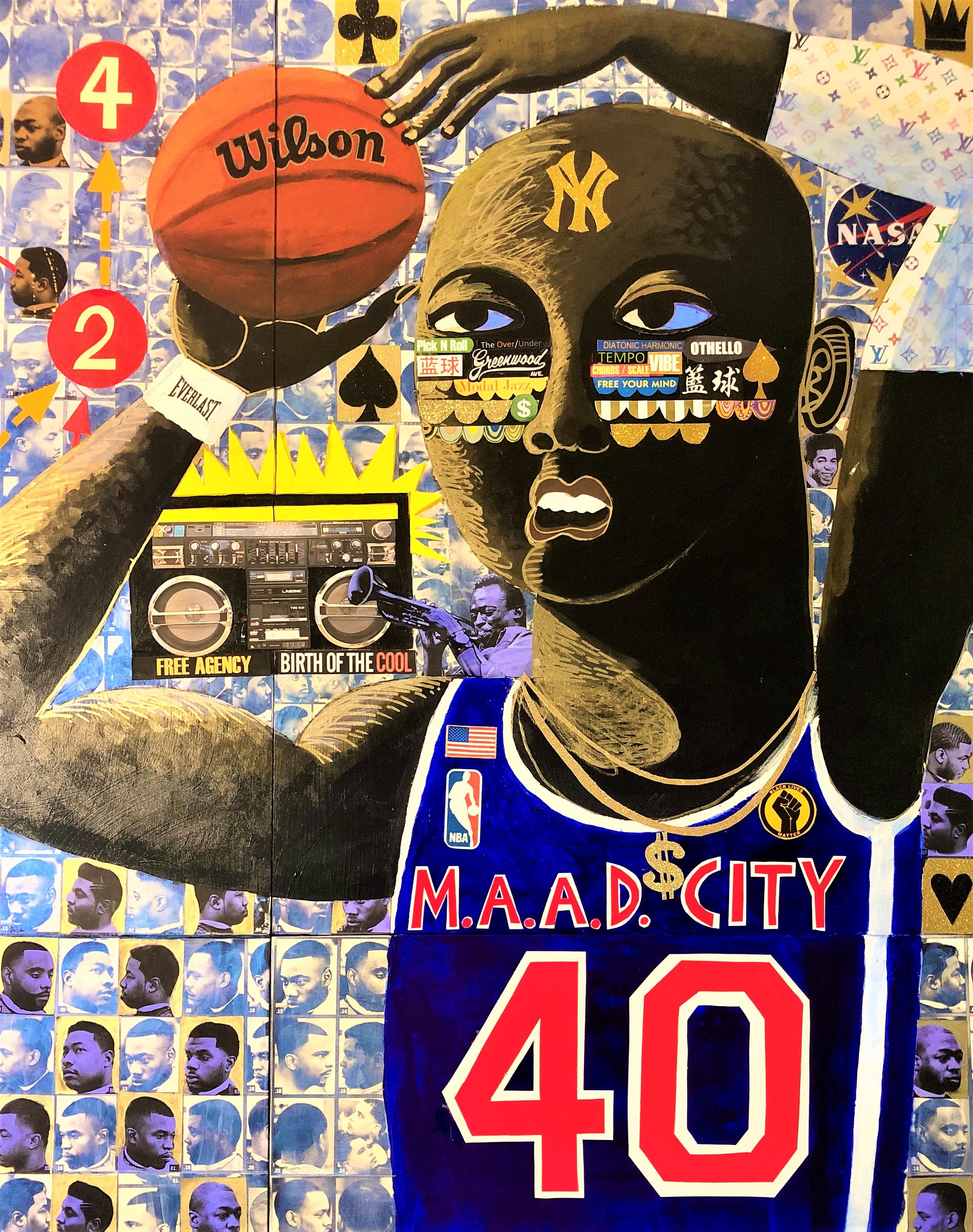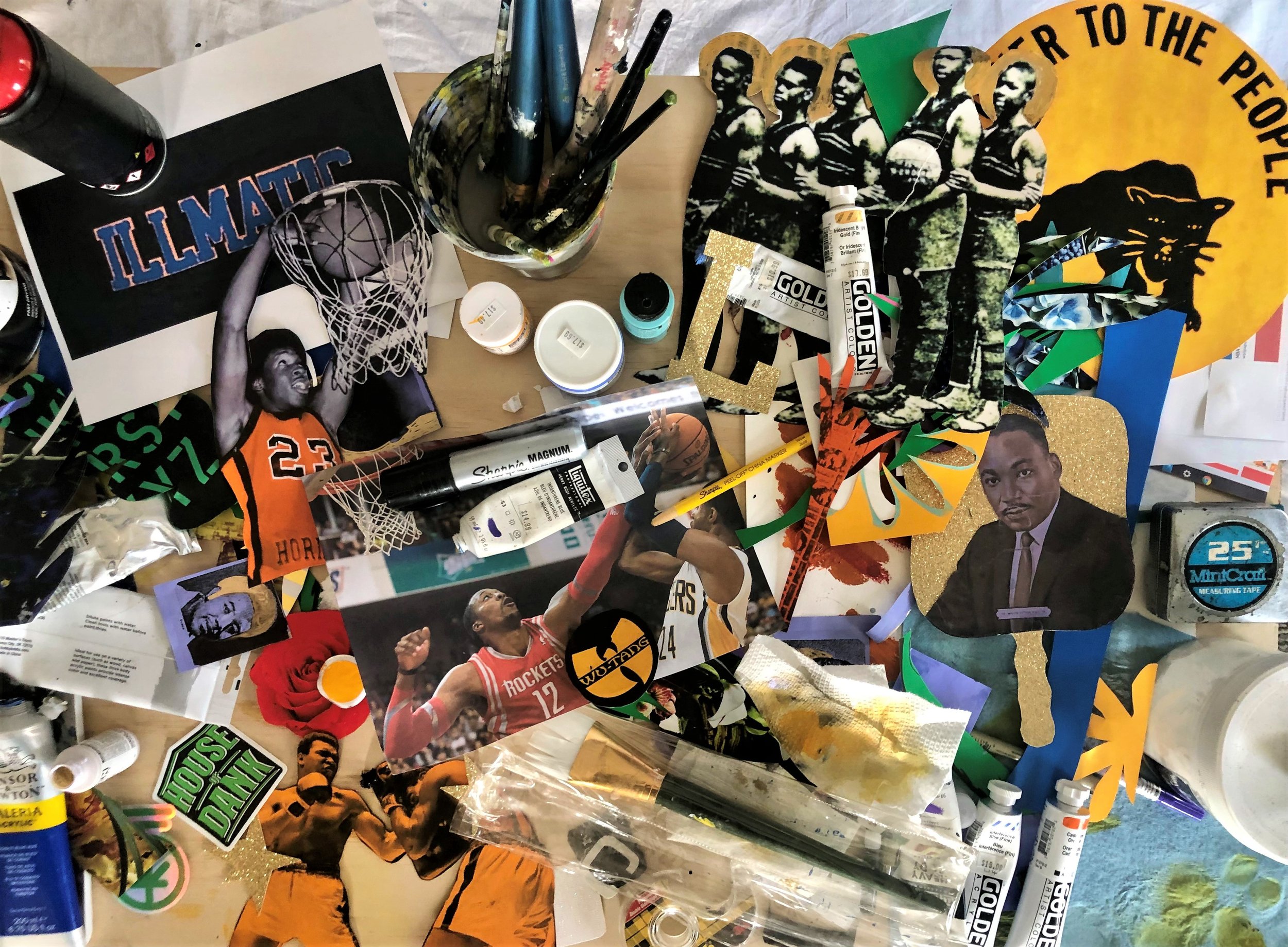Basketball Virtuosity: The Black Aesthetic

The large format mixed-media painting ‘M.A.A.D. City> Zulus’ (B-ball Virtuosity) is skip hill’s visual commentary on contemporary Black male identity in American popular culture and African American aesthetic consciousness, as examined through the framework of American basketball.
‘M.A.A.D. CITY / ZULUS ‘ (Basketball Virtuosity) 2022 Skip Hill Mixed mediums of collage, acrylic paints, inks, paper and varnish on wood panel. Dimensions: 80”h x 89.3/4” x 1.3/4”
Sketchbook notes sourced from various essays and books including Nelson George’s ‘Elevating The Game’ and William C. Rhoden’s ‘40 Million Dollar Slaves’. Danielle Alexandria Davis Howard’s Ph.D. dissertation, ‘Making Moves: The Performance of Black Bodies and The Function of Aesthetics in American Basketball’ has been a most helpful contribution to the conceptual foundation of this artwork.
‘M.A.A.D. City> Zulus’ (B-ball Virtuosity) is a visually arresting and conceptually rich mixed-media artwork that masterfully fuses elements of sports, history, music, and identity. Through bold color choices, intricate layering, and an interplay of realism and abstraction, the piece engages with contemporary Black culture, legacy, and personal narrative.
At its core, the composition features two towering basketball players locked in a moment of intense interaction—one in a golden Lakers-style jersey labeled "ZULUS 64" and the other in a navy-and-red jersey marked "M.A.A.D. CITY 40." These figures are not mere athletes; they serve as cultural avatars, embodying historical resilience, musical storytelling, and the deeply ingrained influence of basketball in Black communities.
The jersey number ‘64’ references the Civil Rights Act of 1964. Other elements include a Wu-Tang sweatband, the Pan-African flag, the NBA logo, the Black Panther Party logo, and a nod to the Zulu Social Aid & Pleasure Club of New Orleans, LA.
The Players:
The leftmost figure, draped in gold and purple, evokes the aesthetic of classic NBA legends while also referencing the Zulu nation, an emblem of African pride and warrior spirit. His purple-toned skin, exaggerated features, and wide-eyed expression align with the stylization of African masks and contemporary street art. His defensive posture, shielding his face, suggests struggle, protection, and a reaction to external forces—whether those be systemic barriers or personal battles.
Opposing him, the rightmost player, clad in "M.A.A.D. CITY" attire, directly references Kendrick Lamar’s good kid, m.A.A.d city, an album that narrates coming-of-age experiences in Compton amidst violence, pressure, and ambition. His jersey and facial collage—featuring text snippets, flags, and urban iconography—blend the language of hip-hop with sports, reinforcing the deeply interconnected nature of these cultural arenas. His poised shooting stance, gripping a Wilson basketball, symbolizes an act of assertion, storytelling, and transformation.
.
The backdrop consists of a repetitive grid of black-and-white portraits, collaged elements sourced from Black barbershop style posters, mugshots, ID photos, or Ife Benin bronze busts. This pattern suggests themes of surveillance, legacy, collective memory and the millions of Black boys dreaming hoop dreams of making it to the NBA. Some faces are highlighted with red circles and numbers within a quickly drawn up scheme of an offensive play. The palimpsest of Black profiles creates a system of hierarchy, selection, elimination, and systemic categorization—perhaps referencing military and sports league drafts, racial profiling, the criminal justice system, incarceration, and the overlooked histories of Black individuals in sports and culture.
The inclusion of elements such as "FREE AGENCY" and "BIRTH OF THE COOL" within the collage hints at themes of ownership, player contracts, the business of sports, the freedom of self-expression, and artistic innovation. The Birth of the Cool reference connects to Miles Davis’ revolutionary jazz album, drawing a parallel between basketball and music as forms of artistic expression and rebellion. The "Supreme" logo on the right player's waistband embeds contemporary streetwear culture into the narrative, reinforcing basketball’s role in shaping global fashion and identity.
Visual Techniques and Artistic Approach
The painting employs a dynamic fusion of techniques—realistic rendering in the faces and bodies, stylized exaggeration in proportions, and bold collage work that integrates text, photography, and paint. The stark contrast between the structured, monochrome background and the lush, vibrant foreground of floral elements creates a compelling visual tension, perhaps symbolizing the organic growth of culture despite the rigid frameworks imposed upon it.
“Run it like we drew it up.” Basketball play diagram adds an element of abstraction to the image.
The background is composed of collaged images from Black barber shop haircut posters. Each profile represents unfulfilled aspirations and dreams of making it to the NBA.
Black Lives Matter patch on jersey serves as a graphic element reflecting sport as a voice for political and social protest.
Orchestrating order out of the chaos of my palette
The floral patterns, in particular, introduce a dreamlike quality, contrasting the intensity of the players’ confrontation. This could represent cultural flourishing, resilience, or even a metaphorical return to roots. The bright, tropical hues juxtaposed against the industrial and sports-driven themes hint at a reclaiming of space—both within the game of basketball and broader cultural narratives.
The size of this work intentionally combines the scale of ancient Assyrian relief carvings that decorated the palaces of king Ashurnasirpal in Nimrud and Nineveh; with the formal composition of Egyptian tomb paintings that extolled for eternity the larger-than-life exploits and royal deeds of the pharaohs. The colorful foliage at the base places the towering figures above the canopy of a jungle, and among the foothills of Mount Olympus battling like demi-gods for the open shot, for the rebound, for basketball supremacy.
‘M.A.A.D. City> Zulus’ (B-ball Virtuosity) is more than an exploration of sport—it is a meditation on history, struggle, and aspiration. By weaving together references from hip-hop, African heritage, sports mythology, and contemporary Black identity, the artist crafts a narrative that extends beyond the court. The piece speaks to the systemic challenges, creative resilience, and the ongoing redefinition of power and success in Black communities.
Through its rich layering of imagery and symbolism, ‘M.A.A.D. City> Zulus’ (B-ball Virtuosity) becomes a profound statement on legacy, competition, and the fight to carve out one’s place—whether in sports, music, or society at large. The work demands not just to be seen but to be unpacked, inviting viewers to consider the intersections of race, fame, and the ever-evolving cultural lexicon of Black excellence.









